Introduction
Implement the following interventions (Table below) to prevent complications associated with critical illness. These interventions are generally limited to feasible recommendations based on high-quality evidence.
| Anticipated Outcome | Interventions |
|---|---|
Reduce days of invasive mechanical ventilation | • Use weaning protocols that include daily assessment for readiness to breathe spontaneously • Minimise continuous or intermittent sedation, targeting specific titration endpoints (light sedation unless contraindicated) or with daily interruption of continuous sedative infusions |
Reduced incidence of ventilator associated pneumonia | • Oral intubation is preferable to nasal intubation in adolescents and adults • Keep patient in semi-recumbent position (head of bed elevation 30- 45 degrees) • Use a closed suctioning system, periodically drain and discard condensate in tubing • Use a new ventilator circuit for each patient, once patient is ventilated, change circuit if it is soiled or damaged but not routinely • Change heat moisture exchanger when it malfunctions, when soiled, or every 5-7 days |
Reduce incidence of venous thromboembolism | • Use pharmacological prophylaxis (low molecular-weight heparin (preferred if available) or heparin 5000 units subcutaneously twice daily in adolescents and adults without contraindications. For those with contraindications, use mechanical prophylaxis (intermittent pneumatic compression devices) |
| Reduce incidence of catheter-related bloodstream infection | • Use checklist with completion verified by a real time observer as reminder of each step needed for sterile insertion and as a daily reminder to remove catheter if no longer needed |
| Reduce incidence of pressure ulcers | • Turn the patient every 2 hours |
| Reduce incidence of stress ulcers and gastrointestinal (GI) bleeding | • Give early enteral nutrition (within 24-48 hours of admission) • Administer histamine-2 receptor blockers or proton pump inhibitors in patients with risk factors for GI bleeding. Risk factors for GI bleeding include mechanical ventilation for greater than or equal to 48 hours, coagulopathy, renal replacement therapy, liver disease, multiple comorbidities and high organ failure score |
| Reduce incidence of ICU | • Actively mobilise patient early in the course of illness when safe to |
Table: Prevention of Complications in Critically Ill Patients
Sources & links
- WHO | PDF Link
- Jamanetwork | Care for critically ill patients with COVID-19 – care for critically ill patients with COVID-19 | Link

